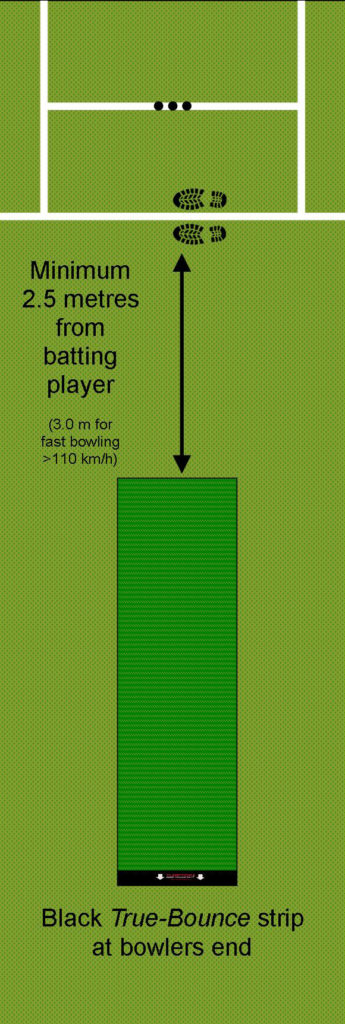Warnings
- The TurfTop mat is designed to make the ball deviate. The batting player should therefore expect erratic bounce, and should have the skills to cope with this movement.
- The front edge of the mat has a True-Bounce strip that helps prevent the ball from flying upwards sharply upon contact. This black True-Bounce strip should always be positioned at the bowlers end. However this system is not foolproof, so batting players should be prepared for a sharply rising delivery and be ready to counter it should it occur.
- The mat should be always be positioned with the back edge of the mat at least 2.5 metres from the batting player’s stance at the crease. If the bowling is fast (>110 km/h) then the mat should be positioned so its back edge is at least 3.0 metres from the batting player’s stance at the crease.
- Batting players should always wear full protective gear - including a helmet, pads, gloves and protector - when the mat is in use.
Using your TurfTop cricket training mat
- Unroll your Turftop mat from its bag as soon as you arrive at the cricket nets. This will give the mat some time to naturally flatten itself while you warm up and don your protective clothing.
- When you have finished your session, roll the TurfTop mat around the tube provided before replacing it in its storage bag.
- Always roll the mat with the grass side outward. Start rolling the mat from the batting players end i.e. the end opposite to the black True-Bounce strip.
- If you have a private or lockable practice net facility, the TurfTop mat can simply be left in place on the wicket, as it is fully UV and weather resistant.
- Do not leave your TurfTop mat in a hot car, or expose it to any other heat source. Excessive heat can deform the True-Bounce strip.
- Store your TurfTop mat in a flat, level and unimpeded space. Storing your mat in a bent or squashed manner can deform it.
- The lateral deviation of a ball on the TurfTop varies depending on the surface below it.
- Hard surfaces (such as concrete) will create a lot of movement.
- Soft surfaces (such as recently-laid or thick artificial turf) give less sideways movement.
- The TurfTop has been optimised for use with a typically hard, flat artificial turf wicket.
- You can use these differences to your advantage. If you are new to using the TurfTop, or if you haven't had much experience in playing against a deviating ball, then using over a more thickly-grassed artificial turf wicket is a good place to start. The ball will deviate less, and it will be slower off the pitch.
- However if you want more deviation (for example, to practice batting against spin bowling, or for wicket keeping drills, then you can use the TurfTop over a hard surface like concrete.
See our video vault for tips, tricks and training drills to get the most out of your TurfTop. We highly recommend watching these videos before using your mat.
